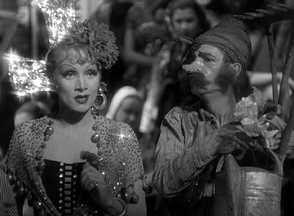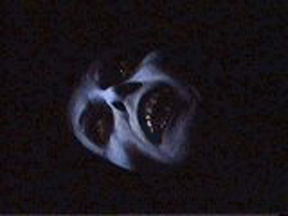
Dark Fantasy
The fantasy level in Dark Energy is quite high, but taken as a whole this group of movies represents a subjective view of reality as opposed to being escapist. Part II I ran into a beautiful take on The Devil is a Woman ('35) that could, specifics aside, be applied to Dark Energy as a whole:
The Haunting and The Exorcist, two venerable horror flicks, were long ago surpassed in the area of shock but still have considerable followings based, I think, on their sensitivity to the dark corners of fear. Viewers not inclined toward a belief in spiritual reality may see the stories as escapist entertainment but, at the same time, identify with the expression of fear in a way that’s quite personal. Of course, cinematic terror doesn't necessarily depend on the supernatural for fuel. More recent horror movies, appearing on a trajectory that runs from Psycho through The Texas Chainsaw Massacre and on, are more earthbound in their inspiration: we have nothing to fear but insane people with sharp implements.
In 1943 Cat People terrified its audience. It was a genuine horror movie in its time. Today it would be better seen as a suspense movie or a gothic movie. On today's freak-out scale, it would barely register. But when Warner Brothers released the Val Lewton set in 2005, it was clear these movies filled a need that was more than casual. When Martin Scorsese waxes reverential, and when recent practitioners of the gothic way, like Guillermo del Toro in Spain and Kiyoshi Kurosawa in Japan, refer to Lewton as an important influence then clearly this wonderful producer, and his understanding of fear as an interior monologue, is still relevant. It's Lewton's connection with reality that still has meaning. The fantasy elements intrinsic to a story in which a human being turns into a killer cat are an imaginative construct that holds our attention while the movie is in play, but it's the shadows it throws - fear, guilt, jealously, you name it - that we recognize and won't shake till the day we die.
|
 Making
the step into
gothic territory requires that you accept (hypothetically) an alternate
reality at the onset, an adjustment many people see as a sort of
capitulation of
intellectual
territory. But even moviegoers willing or, for that matter, anxious
to take such a step insist on some internal logic
that
keeps
the components
from drifting into the aether. This
logic can't necessarily be reduced to matters of plot consistency.
Sometimes it's the
Making
the step into
gothic territory requires that you accept (hypothetically) an alternate
reality at the onset, an adjustment many people see as a sort of
capitulation of
intellectual
territory. But even moviegoers willing or, for that matter, anxious
to take such a step insist on some internal logic
that
keeps
the components
from drifting into the aether. This
logic can't necessarily be reduced to matters of plot consistency.
Sometimes it's the  But
when it comes to fear itself, the gothic movies that rely on fear
of the
unknown are the ones that, it seems to me, get it best, that turn
the viewer's
paranoia inward rather than out. That's why Jacques Tourneur was
so upset
that RKO
insisted
on
showing
the
demon
in Night
of the Demon. The source of fear went from being something
we all carry within us wherever we go to being that 15-foot
thing over there with huge teeth.
But
when it comes to fear itself, the gothic movies that rely on fear
of the
unknown are the ones that, it seems to me, get it best, that turn
the viewer's
paranoia inward rather than out. That's why Jacques Tourneur was
so upset
that RKO
insisted
on
showing
the
demon
in Night
of the Demon. The source of fear went from being something
we all carry within us wherever we go to being that 15-foot
thing over there with huge teeth. 